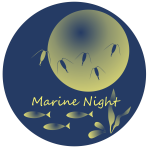18.01.2014
We’ve spent the last three days throwing a lot of equipment and gear into the water to detect whether or not marine life is active in the polar night. For the mooring team aboard Helmer Hanssen the first three days have been very busy recovering a mooring in Isfjorden and deploying two moorings in Kongsfjorden. Meanwhile the plankton team has deployed a variety of nets into the water to see if there is anything out there in the dark waters of Kongsfjorden.
We’ve been chasing zooplankton using two techniques – acoustics and nets. Acoustics tell us where the animals are, and nets tell us what the animals are. The acoustics on the moorings allow the constant monitoring of the zooplankton through the year. It’s a bit like what the NSA is doing in the rest of the world, but we just focus on the Arctic.
There has been surprisingly good illumination over the past days with a full moon and the first hints of light appearing at noon towards the south. We still await for enough light to reveal the skyline behind Ny Ålesund. But mostly it is dark, and since we work around the clock catching up with sleep at random times we all are somewhat lost in time with only the meal times providing some sort of day rhythm.
Before we left Longyearbyen our spiritual leader (Prof Berge) had left with the full moon running with the werewolfs. Where does he get the blood from is the big question for these investigations.
Colin Griffith, Finlo Cottier, Malin Daase, with guest comment by Stig Falk-Petersen


